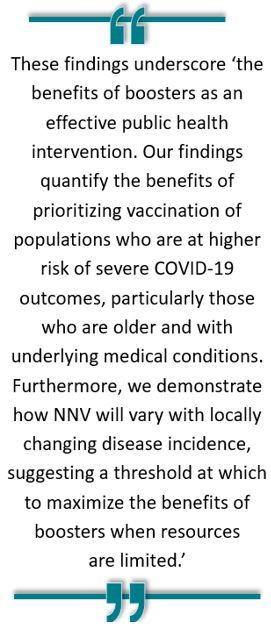Large US Study Suggests Numbers Needed to Vaccinate to Prevent COVID-19 Hospitalizations, ED Encounters
©wachiwit/Adobe Stock

The number of patients needed to receive a COVID-19 booster dose to prevent one medically attended COVID-19 hospitalization or emergency department encounter (ED) was found to range from approximately 40 to 600 in an analysis of data from more than 1.2 million Americans conducted by the US Centers for Disease Control and Prevention’s (CDC) VISION Network.
Investigators reported that the number needed to vaccinate (NNV) was "highly dependent" on local disease incidence, outcome severity, and individual risk factors for moderate-to-severe infection. The retrospective cohort study focused on the period when the Omicron BA.1 variant was dominant in the US and included geographically diverse data.
"Although there are few COVID-19 studies reporting NNV, our results are consistent with findings suggesting that vaccinating small numbers of populations at higher risk can prevent severe COVID-19 outcomes," wrote authors led by Mark Tenforde, MD, PhD MPH, of the National Center for Immunization and Respiratory Diseases at the CDC, in Atlanta, GA. Vaccination policy and guidelines should prioritize populations who are at higher risk of severe COVID-19 outcomes, particularly those who are older and with underlying medical conditions. Furthermore, the evidence suggests that the NNV will vary depending on local disease incidence."
"Although there are few COVID-19 studies reporting NNV, our results are consistent with findings suggesting that vaccinating small numbers of populations at higher risk can prevent severe COVID-19 outcomes."
For the retrospective study, published in The Lancet Regional Health Americas, the research team generated a cohort of immunocompetent adults from 5 VISION Network health systems in Indiana, Oregon, Texas, and Utah during the period of Omicron BA.1 dominance (December 2021 – February 2022). Participants were required to be aged ≥ 18 years and to have complete data on use of the medical system, SARS-CoV-2 lab testing, and COVID-19 vaccination.
Participants were placed in 2 vaccination groups: the first had completed a primary mRNA COIVD-19 vaccine series of 2 doses ≥150 days before the start of the analysis and so were eligible to receive a booster dose; the second had received a 2-dose primary series plus one booster dose ≥7 days before the analysis.
The primary and secondary outcomes of interest were to model the NNV with a first booster dose of vaccine to prevent 1 COVID-19-associated hospitalization and 1 COVID-19 ED encounter, respectively, among patients with laboratory-confirmed SARS-CoV-2 infection during the period of Omicron BA.1 variant predominance.
The research team used hazard ratios (HR) for each of the 2 outcomes to estimate NNV across geographic settings and populations and further stratified the results by 3 25-day periods.
Study cohort. From an original pool of 1 811 651 vaccinated individuals with either an ED visit or hospitalization, the final cohort numbered 1 285 032 participants. The majority of the cohort was White (77.1%) and non-Hispanic (82.8%) and just more than half (59,6%) were women; 43.2% were aged 18–49 years, 28.3% 50–64 years, and28.5% ≥65 years. The team also reported that 61% of participants had at least 1 underlying medical condition, including 12% with one or more respiratory condition and 58% with non-respiratory conditions. Among them, there were 938 hospitalizations and 2076 ED encounters during the study period.
FINDINGS
At the beginning of the study, the authors reported, 37.2% of patients received a booster (ie, third dose) and 62.8% received only a primary series of 2 doses. Patient characteristics were similar across the 2 vaccination groups although those who had received a booster tended to be older, they observed.
NNV. Median estimated NNV to prevent one hospitalization was 205 (range 44–615) and NNV was lower across the 3 25-day study periods for adults aged ≥65 years (110, 46, and 88, respectively) and those with underlying medical conditions (163, 69, and 131, respectively). Median estimated NNV to prevent 1 ED encounter was 156 (range 75–592). The higher NNV for hospitalizations vs for ED encounters reflects differences in outcome severity, according to the researchers, and was influenced by participant risk factors as well as incidence of disease in specific locations.

Hazard ratios, crude incidence. As a reference group, Tenforde and colleagues used patients who had received a 2-dose series; the adjusted HR for those who had received 3 doses was 0.24 (95% CI, 0.20–0.29) against COVID-19-associated hospitalization, while the aHR was 0.31 (95% CI: 0.27–0.36) against COVID-19-associated ED encounters. The crude incidence rates, ie, number of events by person-days, reflected numeric differences between the 2 vaccination groups: for hospitalizations the researchers reported 4.9 events per 1 million person-days for participants who received 3 doses vs 16.4 events/million person-days for those who received 2 doses; for ED encounters they recorded 9.6 events/million person-days for 3-dose recipients vs 37.3 events/million person-days.
The investigators cite several limitations of the analysis, including that NNV is a context-specific measure and so direct comparisons between NNVs is limited. They also note that the analysis did not account for prior infections or for indirect benefits of vaccination (eg, reduced transmission). Further, selection bias by virtue of restricting participation to those with a medical encounter within the prior year may have created a cohort not fully generalizable to the US population.
In conclusion they state that these findings underscore “the benefits of boosters as an effective public health intervention. Our findings quantify the benefits of prioritizing vaccination of populations who are at higher risk of severe COVID-19 outcomes, particularly those who are older and with underlying medical conditions. Furthermore, we demonstrate how NNV will vary with locally changing disease incidence, suggesting a threshold at which to maximize the benefits of boosters when resources are limited.”
Source: Adams K, Riddles JJ, Rowley EAK, et al. Number needed to vaccinate with a COVID-19 booster to prevent a COVID-19-associated hospitalization during SARS-CoV-2 Omicron BA.1 variant predominance, December 2021–February 2022, VISION Network: a retrospective cohort study. Lancet Reg Health Am. 2023;23:100530. Published online June 14, 2023. doi:10.1016/j.lana.2023.100530